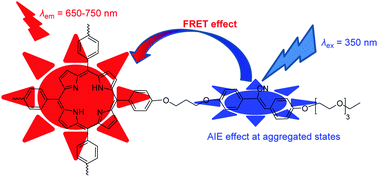A first porphyrin liquid crystal with strong fluorescence in both solution and aggregated states based on the AIE-FRET effect†
Abstract
Porphyrins are good near-infrared fluorescent materials, but the strong self-assembly stacking resulted in the aggregation-caused quenching (ACQ) effect, limiting their emissive performance in aggregated states. In this work, a novel diphenylacrylonitrile–porphyrin derivative with multiple polyglycol chains on the periphery was designed and synthesized as an excellent near-infrared-emissive liquid crystalline material in both solution and aggregated states, which was first observed for porphyrin liquid crystals. It exhibited a high self-assembly ability with the ordered hexagonal columnar mesophase between 70 and 120 °C approximately. The strong AIE-FRET effect was produced based on the overlap of the emission wavelength of diphenylacrylonitrile and the absorption wavelength of the porphyrin, resulting in the excellent near-infrared emission in both solution and aggregated states. The pseudo Stokes shift was as large as 210 nm and the fluorescence quantum yield reached 0.12 in the solid state. Moreover, this porphyrin liquid crystal displayed low biotoxicity and excellent fluorescence bio-imaging ability in living cells, opening a new application prospect for porphyrin liquid crystalline materials.



 Please wait while we load your content...
Please wait while we load your content...